

PORT FOLIO
Priscilla Hubbard
A C K N O
C
O U N T RY
I wish to acknowledge that I am learning and designing on the unceded lands of the Wadjuk people of the Noongar nation. I am grateful for their enduring custodianship of our land, sea and sky. I pay my heartfelt respect and gratitude to elders past, present and emerging for their care of Country and generous sharing of knowledge.

I also acknowledge that my positionality is non-Aboriginal and my curiosity for indigenous knowledge and practice of Landscape Architecture should not be at the expense of, nor cause offence to, any Aboriginal or Torres Strait Islander.
Always was, always will be Aboriginal Land.





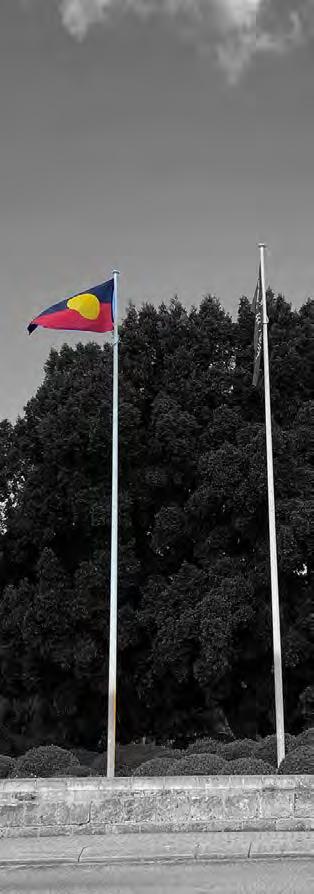

R E S U M E
E N V I R O N M E N T & C O M P L I A N C E DISSERTATION
STUDIOS CULTURAL / REPORT WRITING
ADDITIONAL MLA PROJECTS

Fig. 2: Presenting at launch of Town of Victoria Park’s “More than Human” exhibition, 2023.


+61 (0)407 326 599

djlocker@optusnet.com.au

West Leederville, WA, 6007

LinkedIn profile
E D U C A T I O N
Enrolled
MASTERS OF LANDSCAPE ARCHITECTURE
University of Western Australia
2022 to Present (High Distinction Average)
HONOURS
“The seedling recruitment of the mangrove species Avicennia marina in the Port Hedland area”.
Murdoch University
1994
BACHELOR OF SCIENCE
Multidisciplinary Science
Curtin University 1991 – 1993
P R I S C I L L
P R O F I L E
I am a senior environmental specialist with extensive experience in approvals, risk and compliance and scientific studies.
My current enrolment in UWA’s Masters of Landscape Architecture not only demonstrates my curiosity for continued learning but also my commitment to identifying creative design responses to contemporary landscape issues. I am excited to be a part of this joyful, problemsolving discipline.
I have a proven history for achieving results, considering myself to be process oriented, evidence based and a problem solver. I have an eye for detail but also see the big picture. I am recognised for being extremely well organised, conscientious, determined and reliable. I love both the technical and creative. My relationship skills, enthusiasm and sense of fun are characteristics that are beneficial to all organisations.
My objective is to source a challenging role in a professional environment that is progressive, creative, has robust governance / processes and above all is both supportive and values integrity.
C A R E E R S U M M A R Y
Please refer to my LinkedIn profile for additional role specific information and endorsements.
Woodside Energy Ltd | Perth, Australia www.woodside.com.au
2015 to 2017 GWF-2 | Senior Environmental Adviser
2014 to 2015 Regulatory Compliance Improvement Project | Senior Adviser
2010 to 2013 Marine / Environment | Oil Spill Preparedness Coordinator
2009 to 2010 Pluto | Senior Environmental Adviser
2007 to 2009 Browse | Senior Environmental Adviser
2005 to 2007 African Business Unit | Environmental Adviser
2001 to 2005 Supply Operations (Offshore) | Environmental Adviser
2000 to 2001 C orporate | Environmental Adviser
City of Westminster | London, UK. www.westminster.gov.uk
1999 Street Environmental Manager
BHP Iron Ore | Port Hedland, Australia www.bhp.com
1994 to 1998 Nelson Point | Environmental Officer
R E F E R E E S
LANDSCAPE ARCHITECTURE
Ms Rosie Halsmith Lecturer | UWA rosie.halsmith@uwa.edu.au
Prof. Maria Ignatieva
Professor of Landscape Architecture | UWA President of URBIO maria.ignatieva@uwa.edu.au https://orcid.org/0000-0002-5273-1644
ENVIRONMENT / COMPLIANCE
Mr Cameron Grebe
Deputy CEO Offshore Energy Regulator | National Offshore Petroleum Safety and Environmental Management Authority (NOPSEMA) cameron.grebe@nopsema.gov.au
Dr Luke Smith
Chief Environmental Scientist | Woodside Adjunct Professor | Ocean Institute at UWA luke.smith@woodside.com.au
+ Highly organised, conscientious and an ability to solve complex problems: Determination to realise complicated tasks by thinking laterally without compromising standards or HSE. Includes contract development with a Federal Government research organisation, organising logistically complex environmental studies both in Australia and Africa and redefining organisational oil pollution emergency plans during a period of regulatory change. My high performance during my current MLA studies demonstrates my ability to retrain and creatively respond to presented design problems.
+ Confident and motivated leader and team player: Recognised for visionary, participative and affiliative leadership styles. Comfortable working in multidisciplinary teams and liaising with Management, Joint Venture Participants, Government, Engineers, Scientists, Lawyers, Academics and other peers. Provision of formal supervision of employees and contractors, as well as informal mentorship to other students during studio site analysis phases.
+ Excellent Communicator: Development and delivery of awareness sessions and training relating to environmental management. Numerous presentations to Management, JVPs and during university classes etc. Excellent Regulator relationships. Strong technical writing skills having prepared many environment plans, emergency plans, reports, procedures, and studies scopes of works. Also contributed / authored executive and board papers. Current university studies have further honed verbal presentation, visual communication techniques, essay writing, report and research proposal report writing skills.
+ Health and Safety committed: Prioritise H&S having had a close affiliation with this discipline for entire working career.
+ Risk and Compliance focused: Central to responsible environmental management is compliance and risk management. Both are always front of mind in my approach and decision making.
+ Process oriented: Complied with requirements of various corporate management systems. Contributed to management system development, review implementation and monitoring primarily incorporating HSE and R&C requirements / improvements. Application of design processes during university studios.
+ Auditing ability: Participation in project Assurance Check audits to assess the environmental performance of developments and projects, ISO14001 audits and external contractor audits. Preparation for, and support of, regulatory audits.
+ Effective Project Manager: Project Management / Supervision of Contractors and Consultants. Ability to leverage off extensive networks. Proven ability to manage high work-loads and still meet deadlines. Competent user of MS Project and MS Excel to schedule and manage deliverables. Effectively managed budgetary processes including annual budgets, CTR and purchase orders.
+ Strong scientific background: Technical strengths in the fields of oil spill preparedness, waste and produced water management, mangroves and cetacean monitoring. University studies have refreshed botanical and ecological knowledge on the Swan Coastal Plain as well as familiarity with current invasive species / urban forest literature. Recent Athens intensive studio demonstrates continued ability to source data and analyse unfamiliar environments.
+ Creative: Enjoy hand and digital drawing; and providing creative solutions in design work.
A W A R D S / R E C O G N I T I O N
+ Microsoft Office - Word, Excel, Project
+ Adobe Creative Suite - InDesign, Illustrator, Photoshop
+ Autocad
+ QGIS
+ Learning Rhino T R A I N I N G
Emergency Response / Spill Preparedness
+ Coordinate Incident Response PMAOMIR418A - (ERGT, 2016)
+ Oil Spill Management - (AMOSC, 2013)
Health and Safety
+ Safety Conversations -(IFAP, 2016)
Other
+ Effective Negotiating and Influencing - (ENS, 2010)
+ ISO14001 Auditing - (QAS, 2002)
+ Train the Trainer (AIM, 2000)
+ UWA School of Design Exhibited 5/6 semesters Five projects showcased in Winter / Summer Catalogues
+ Town of Victoria Park | 11/09/23 to 06/10/23 “More than Human” exhibition Winner People’s Choice
+ Chamber of Minerals and Energy (CME) | 2013 Outstanding Professional Woman in Resources Finalist
I N T E R E S T S
+ Drawing classes (Fremantle Art Centre)
+ Gardening - including natives, orchids, fruit trees, xerophytic plants, lawn etc
+ Hiking and walking
+ Travel
+ Current affairs

E N V I R O N M E N T & C O M P L I A N C E
Fig. 3: Changing a dust deposition guage, BHP Iron Ore, Port Hedland.
Site Analyses / Environmental Studies:
+ Comprehensive literature review on Polyphagus Shothole Borer and associated research proposal (High Distinction, S2/24) for planned MLA Dissertation by Design (S2/24 and S1/25)
+ Demonstrated versatility working in intrastate and international environments (e.g. Athens, 2024)
+ Site analyses on Swan Coastal Plain environments such as remnant Banksia woodlands, ephemeral wetlands and urban landscapes (2022-Present):
‐ Vegetation surveys
‐ Desk top water and soil quality analyses
‐ Literature reviews on fauna, flora, PSHB, Phytophthora, pollination, climate change effects etc
‐ Public Life Study Russell Square (S1, 2022)
+ Scoping of Rankin Bank baseline and cuttings monitoring program with Australian Institute of Marine Science (AIMS, 2016-17)
+ Coordination of Pluto LNG Project’s $8M environmental offset programme (Woodside, 2010):
‐ 5 terrestrial projects - including flora taxonomy, short range endemics, ethno-botanical surveys
‐ 2 marine projects - Dredge capability building (became the basis for the WAMSI dredging node) and proposed Dampier Marine Park studies
+ Coordination of Browse LNG Development’s Kimberley theme studies (Woodside, 2008)
+ Contract development and scoping of a $34M baseline science programme at Scott Reef with AIMS (Woodside, 2007-08)
+ Other miscellaneous Browse LNG Development studies (Woodside, 2007-08):
‐ Baseline water, sediment and ROV assessment
‐ Acquisition of satellite imagery datasets
‐ Hyperspectral programme at Scott Reef
‐ Ecotoxicity assessment of reservoir fluids
+ Coordination of Mauritania Produced Formation Water study (Woodside, 2005-06)
+ Coordination of Marine Mammal Observation programmes for seismic campaigns in Mauritania (Woodside, 2006)
+ Oil and Gas Operations / Production facility studies (Woodside, 2002-05):
‐ Produced formation water studies (fish biomarker, characterisation, ecotoxicity and modelling)
‐ Process chemical environmental risk study
‐ Offshore drill cutting sediment assessments
+ Nelson Point Iron Ore Port and Rail facility and HBI construction site monitoring (BHP, 1994-98):
‐ Dust monitoring (High Vol., β-Gauges, dust deposition gauges)
‐ Hyperspectral study with CSIRO evaluating spatial dust effects on mangroves
‐ Ground, storm and harbour water monitoring
‐ Ambient noise monitoring programmes (use of loggers and reporting)
‐ Revegetation monitoring Shay Gap / Goldsworthy decommissioned mines
+ Developed a rehabilitation programme for a degraded mangrove creek system; supervised fieldworkers (TAFE Indigenous horticulture course), recruitment trials, broadscale revegetation programme and monitored seedlings and physico - chemical attributes (BHPIO, 1995-98)
+ Mangrove research including leaf litter generation, decomposition rates and crab herbivory experiments in the Port Hedland area (AIMS volunteer, 1994)
Oil Spill Preparedness:
+ Preparation of detailed Corporate / Regional Oil Spill Response Plans and First Strike Action Plans (Woodside, 2011-13), African Business Unit Oil Spill Contingency Plans (Woodside, 2005-07)
‐ Participation in crisis and emergency response incident management team exercises
‐ Knowledge gathering via laboratory assessments and ground-truthing coastlines (Woodside, 2012)
‐ Company representative on APPEA oil spill working groups to build collaborative capability in areas such as oiled wildlife response and use of dispersants
Impact Assessment / Approvals:
+ Interacted with multiple regulators such as NOPSEMA (Cth.), AMSA (Cth.), DEE (Cth.), DoT (WA) and DMIRS (WA)
+ Preparation / execution of Environmental Plans, including managing associated commitments (Woodside, 2001-17)
+ Co-authored and project managed the preparation of the ESIA for the West African Tiof oil field development opportunity (Woodside, 2006-07)
Risk and Compliance
+ Contributed to the development of an ISO19600 compliant process (WEL Regulatory Compliance Management Operating Standard) (Woodside, 2014)
+ Contributed to the scoping and selection of a compliance information management system. Mapped all processes as inputs for the proposed GRC software platform (Woodside, 2014-15)
+ Managed commitments / legal obligations in regulatory compliance database (Woodside, 2016-17)
Technical writing
+ Masters level academic essay / report writing and analysis of peer reviewed literature (UWA, 2022-present)
+ Technical scoping for engineers, lawyer, architect, arborist, surveyor etc (SP868 Strata Council, 2021 to Aug. 2023)
+ Proposals and reports for Boards, AGMs etc (Personal, 2017-2021)
+ Preparation of Environment Plans, oil spill / emergency response documentation, environmental sections of services / works contracts, management system components (Woodside, 2000-17)
+ Contributed to ExCom papers (Woodside, 2009, 2013)
Audits
+ Preparation and hosting of regulatory inspections (Woodside, 2001-17)
+ Coordination of GWF-2 environmental inspections of primary installation vessels and survey vessels (Woodside, 2016)
+ Assurance Check of Australian Marine Oil Spill Centre capability (Woodside, 2011)
+ Assurance Checks for Pluto, NRB and Sunrise development opportunities (Woodside, 2004-07)
+ ISO14001 pre-audits of production facilities and coordinated ISO14001 audits (Woodside, 2004-05)
Measurement and Reporting
+ Developed and executed a suite of regulatory compliance metrics, including Corporate KPIs routinely monitored by Woodside Executive Committee (Woodside, 2014-15)
+ Management, Joint Venture Partner and Governmental reporting (ie National Pollutant Inventory, Production Sharing Contract reporting obligations, Annual EP Performance Reporting, annual Sustainability report (Woodside, 2000-17)
Miscellaneous
+ Contractor management including tender evaluation, and tenderer / contractor briefings (Woodside, 2015-17; SP868 Strata Council, 2021)
+ Promotion of Woodside’s environmental performance via environmental awards - ie external environment award submissions 2002-4 DoIR’s Golden Gecko award and 2002 WA Environment Award winner for Air Quality (Green Transport). Coordination of Woodside’s internal award programmes (Woodside, 2000-01)
+ Local management and contract compliance of the £16M p.a “waste collection, street cleansing and ancillary services” contract (Westminster City Council, 1999)
Skills based volunteering
+ AILA Urban Greening Strategy Working Group (2024)
+ Strata Council Secretary for 30 unit apartment complex (SP868, 2021 to 2023)
+ Co-authored a Sustainability Action Plan (Bold Park Community School, 2018-19)
+ Local Government Authority approvals and logistics planning for a 12,000 person event (St. Mary’s Anglican Girls School 5 yearly Fair, 2015-16)


DESIGN STUDIOS
Fig. 5: LACH5422 Retaining wall / sit spot (Physical model made from laser cut card).

4.1: L A C H 5 5 2 4 [S E M. 2 2 0 2 4]
UWA Unit Coordinator
Dr. Simon Kilbane
Brief.

This design studio asks students to explore contemporary ideas of cemetery and memorial park planning and design and memorialisation in all their richness, diversity and detail. Within the context of an existing but expanding location – the Rockingham Regional Memorial Park – students should respond to the growing need for increased land for this purpose as earmarked in long held metropolitan planning schemes and consider a design response developed through a respectful, well-rationalised, defensible and creative way.
Client(s).
Metropolitan Cemetery Board.
Design response - RRMP Aboretum and Bidi
I started this studio in a place of deep sadness and grief as my mum, Alison, had recently passed away. This studio provided a unique opportunity for me to sit longer in the moment and think deeply about death. While this was challenging at times, I believe this has ultimately helped my healing and I am grateful for the studio experience.
Mum definitely influenced my design. Until now, I have had very little exposure to death. I therefore wanted to create a space that families engage with over the course of their lives, so they are re-sensitised to death. Importantly, when they eventually pass, they will have built an authentic connection fostered over time to their final resting place. I also took comfort from a memorial tree we planted to honour Mum. This prompted the idea to plant commemorative trees now and not at life’s end, which could be decades away given the younger population of the south-metropolitan area. Trees are desperately needed for habitat, including the threatened cockatoos that frequent this site and for critical ecosystem services. I want users of the RRMP to create their own unique stories at the site by planting and forming a relationship with their specific trees whilst they are alive. Eventually, their ashes or compost would be placed under their mature tree.
My design on the 60Ha site includes features such as the arboretum (both native and exotics); a space for natural burials; a 3km walk trail / Bidi to encourage use of the site as Public Open Space; multi-functional low brick, memorialisation walls that fringe sections of the walk trail; and a series of multi-purpose chapels and pavilions that showcase contemplative gardens on the edges of a series of architecturally designed buildings. I envisage these spaces being used for both joyous activities such as weddings on weekends, birthday celebrations, art exhibitions and picnics; as well as for death rituals such as funerals, wakes and even a safe/supportive space for voluntary assisted dying.
+ Full Folio - TBC
+ AILA and Metropolitan Cemetery Board - Pecha Kucha presenter
+ UWA School of Design end of semester exhibition 2024 (1/6 students)
+ UWA School of Design (not yet published) (1/2 students)
+ UWA School of Design Instagram
Acknowledgement of Country
I wish to acknowledge that I have been learning on Noongar Country. I pay my heartfelt respect and gratitude to elders past, present and emerging for their care of Country and generous sharing of knowledge.

LEGEND:



ROCKINGHAM REGIONAL MEMORIAL PARK
Creating and preserving your family's precious memories
Main entrance: New Baldivis Road entry / roundabout.
Chapels:
Two non-denominational “celebration of life” event spaces.
Limestone scarp: Vertical garden feature / bird habitat viewed from Chapel windows.
Walk trail loop / Bidi: 3km loop with memorialisation opportunities. Connects to KLT.
Car Park:
Services chapel and woodland
Cafe: Services chapel events / other visitations.
Plant
Future technology buildings: Rysomation and composting.
Indigenous Burials: Wadjuk and Bindjareb Noongar burial ground. Co-designed.
LEGEND:
Main entrance:
New Baldivis Road entry / roundabout.
Chapels:
Two non-denominational “celebration of life” event spaces.
Limestone scarp:
Vertical garden feature / bird habitat viewed from Chapel windows.
Walk trail loop / Bidi:
3km loop with memorialisation opportunities. Connects to KLT.
Car Park:
Services chapel and woodland burial.
Cafe:
Services chapel events / other visitations.
Plant nursery: Onsite exotic / native trees.
Future technology buildings: Rysomation and composting.
Indigenous Burials: Wadjuk and Bindjareb Noongar burial ground. Co-designed.

Pavilions:
Rentable plant named multi-function spaces capitalising on view
Walls:

Memorial wall, columbarium, seating, lighting and housing for utilities Tree memorial / Arboretum: Exotics (Sentinel), no plaques, secondary path network required. Woodland Burials:
Preferably vertical burials near Remnant bushland.
Land Art: ‘Burial mounds’ / mowless
Lake / Living stream / Swales: Phytoremediation / WSUD to support Fe removal and trap sediments.

Meeting Tree: Cupaniopsis anacardiodes (Tuckeroo)
Remnant vegetation: Restoration / preservation.
Continue native revegetation: Steeper areas that are less accessible. Include wildflowers. Kwinana Trail Loop.
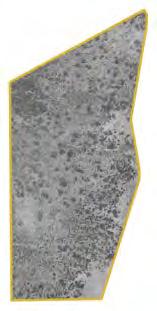
Site is relatively undisturbed.


Site remains relatively undisturbed.


Land clearing apparent. Potentially for agricultural purposes.



Sand quarrying occuring eastern boundary. Sand and limestone operations also commenced Millars Road facility.



Quarrying continues.
EPA Public Environmental Review process for landfill 1991. Govt. implements Bush Forever program in 2000.
obviously operational.
Half of site now affected by quarrying.
Cemetery roads laid out.


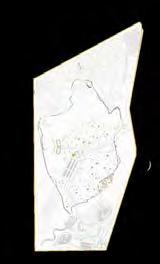


2. Timeline of site, 1953 to present
Shrinking


















ROCKINGHAM REGIONAL MEMORIAL PARK
ROCKINGHAM REGIONAL MEMORIAL PARK
ROCKINGHAM REGIONAL MEMORIAL PARK
19. Fragment 1 plan - Meeting tree, cafe, car park and swale.
ROCKINGHAM REGIONAL MEMORIAL PARK
ROCKINGHAM REGIONAL MEMORIAL PARK
17. Fragment 1 section - Roundabout.
18. Fragment 1 section - Swale and road.
Fig. 11: Perspectives - Welcome roundabout and “Jarrah” Chapel (Photoshop).
Fig. 12: Plan view - Meeting tree, “Tuckeroo” cafe, car park and swale (AutoCad, Illustrator).
Fig. 13: Sections - long section view of chapel, arboretum, meeting tree and cafe. Section of welcome roundabout on site of existing boulders (AutoCad, Illustrator).









perspectives - Arboretum and Bidi / walls.
Bidi / memorial wall Arboretum
23. Fragment 2 Plan - Arboretum
21. Fragment 2 Sections - Columbarium and memorial walls. 22. Fragment 2 Section - Arboretum.
Fig. 14: Perspectives - Arboretum, memorial wall (Photoshop).
Fig. 15: Plan view - Arboretum (AutoCad, Illustrator).
Fig. 16: Sections - Columbarium / Memorial walls and Arboretum (AutoCad, Illustrator).
















Break out spaces - Banksia pavilion enclosed garden
24. Fragment 3 perspectives - Banksia pavilion enclosed garden and front forecourt.
27. Fragment 3 plan - Banksia pavilion.
25. Fragment 3 sections - Banksia Pavilion.
26. Fragment 3 section - natural burials Vertical and horizontal.
Fig. 17: Perspectives - Enclosed Banksia garden and forecourt of the “Banksia Pavilion”(Photoshop).
Fig. 18: Plan view - Banksia Pavilion (AutoCad, Illustrator).
Fig. 19: Sections - Natural burials, “Banksia” Pavilion enclosed garden and sit / retaining walls (AutoCad, Illustrator).








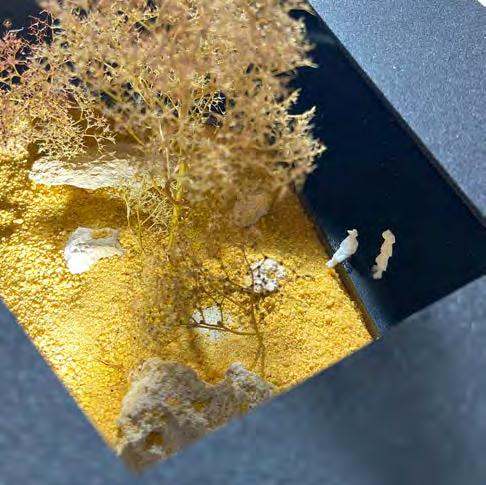
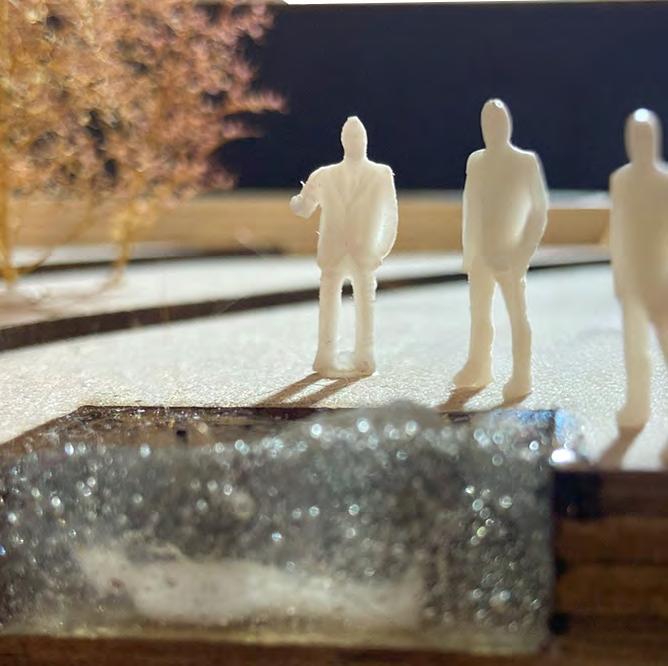

I wish to express my gratitude to Simon for his patient guidance over the course semester. I have learnt so much. Thanks to
25. Fragment 3 sections - Banksia Pavilion.
Fragment 3 section - natural burials Vertical and horizontal.
Gratitude
Dom and Stuart for their time and
28. Fragment 3 physical model - Banksia Pavilion.
Fig. 20: Physical model - Banksia Pavilion (Laser cut card) 15

4.2: A
R
C T 5 3 0 1 [J A N. / F E B. 2 0 2 4]
UWA Unit Coordinator
Dr. Nigel Westbrook (with Kalliope Kontozoglou)
Brief.
To transcend the shallowness of the familiar perception of place and re-imagine a public space that reclaims central Athens in the vicinity of Iera Odos (the “Sacred Way”).
Client(s).
Athens and her many diverse residents and visitors - both human and non-human, biotic and abiotic.
Design response - Κεραμεικός
The green reclamation of both the city’s buildings and the rural archeological ruins captivated me throughout this intensive studio experience. Similarly, I was enamored by the beauty of the decomposing neo-classical residential architecture - stuck in statis by well-intentioned 1979 heritage legislation, but deteriorating from lack of repair / maintenance funding. The scenario that presented to me was to honour the memory of these uninhabited buildings by converting them into public garden spaces. This “rebirth” narrative also felt a fitting extension of the core principles of the Eluesian Mysteries - the celebration of fertility of the land and the universal cycles of life and death.
The overall intent of my proposed design response is to showcase these decomposing architectural beauties, while creating a safe, rehabilitated public open space that authentically connects to the broader neighbourhood. The design would also contribute to the provision of important additional urban ecosystem services and habitat.
My proposed site encompassed an entire block (0.64Ha), located 250m from the Kerameikos cemetery. In its current state the site comprises three registered neo-classical buildings in varying states of decay, two multi-story commercial/residential buildings, a single level dwelling, a series of inaccessible archaeological ruins, a makeshift car park and an otherwise sunken, degraded, ruderal space.
The design comprises four elements:
1. To create “living buildings” by re-purposing the deteriorating neo-classical building with vertical and roof gardens. This site would act as a demonstration garden for a potential network of reclaimed buildings that currently sit in limbo.
2. To create ghostwalls / fences of since demolished neo-classical buildings. These trellised dividers act as “public garden rooms” memoralising a lost Athens.
3. To create a non-interactive peristyle walled “underworld” garden on the site’s sunken land. This aspect would need to work sensitively with the site-based ruins. Three other themed gardens would occur at ground level - naturalistic, wildflowers and scented.
4. To provide a green corridor from Eleftheria Square to Kerameikos cemetery.



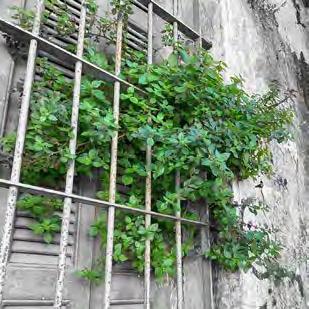






Fig. 22: Green reclamation of neoclassical buildings (Photoshop).
Fig. 23: Trace of Neoclassical houses at chosen site (Autocad, Illustrator).




































- Onsite acrhaeological ruins (3rd and 4th Century BC)



Fig. 25: Section - Metaphysical ghostwalls of since removed neo-classical buildings (Autocad and Photoshop).
Fig. 26: Perspective - Naturalistic garden (Autocad, Rhino, Photoshop).
4.3: L A C H 5 4 2 4 [S 1, 2 0 2 3]
UWA Unit Coordinator
Rosie Halsmith
Brief.
To create a more-than-human landscape strategy in the local government area of Victoria Park, that seeks to solve a problem for a non-human resident at this site. The site’s remnant vegetation area (Jirdarup Bushland Precinct) will be the investigation starting point. One, specific non-human resident of the Victoria Park area will be your client. More-than-human strategies will respond to the current, as well as future, conditions in Victoria Park, taking into account changing climate and social conditions. The design process must comprise 1) analysis, 2) strategy, 3) design development and 4) design communication.
Client.
The native bee, Rozenapis ignita, was the client selected for this folio. Stages 1 and 2 focused solely on this species, where as Stages 3 and 4 broadened the focus to native bees of the Perth area (including cavity and burrowing bees).
Design response - Making a Beeline to the Remnants.
To provide improved connectivity for native bees between three fragmented remnant banksia woodlands located in the Town of Victoria Park and adjacent City of South Perth. This will support important foraging and reproductive floristic requirements for native bees, while simultaneously ensuring pollination services critical to the survival of the remnant woodland flora. These pollination corridors, provide increased crosspollination, which strengthens the remnant bushland’s genetic diversity, thereby improving resilience. As native bees have a flight range limited to 1km (500m return radius) bee “lines” that provide their specific floristic and nesting requirements at least every 500m between the remnant patches are proposed. Ideally, the key pit stops located at the 500m markers would be human / bee interactive living labs and bee friendly gardens. Temporally, the design would utilise interim infrastructure (bee towers or “motels”) that double as wayfinding guides until mature trees can naturally provide these nesting habitats. These proposed biodiversity positive interventions would require collaboration between both LGAs, key state government agencies whose land access is required and local residents
+ Full Folio - Making a Beeline to the Remnants
+ Perth Design week - Pecha Kucha presenter 19/03/24 (invited by AILA)
+ Town of Victoria Park - More than Human event / exhibition 2023 (1/6 students and Winner people’s choice)
+ Town of Victoria Park - request to use Bee Hotel design 2024
+ UWA School of Design end of semester exhibition 2023 (1/5 students)
+ UWA School of Design 2023 Winter brochure (1/3 students)
+ UWA School of Design Instagram Making a Beeline to the Remnants

Fig. 27: Damien Newman’s design squiggle and R.ignita (AutoCad, Illustrator).

Fig. 28: R.ignita Umwelt. Relying primarily on sight and smell, R.ignita locates their preferred food source of Jacksonia spp. nectar and pollen (which many other species of bee cannot pollinate due to the flower’s odd shape), as well as other niche floristic requirements associated with their reproductive cycle (AutoCad, Illustrator).








































































500m (minimum) native bee “motel” / floristic pitstops



















































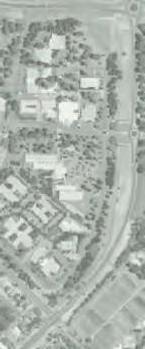













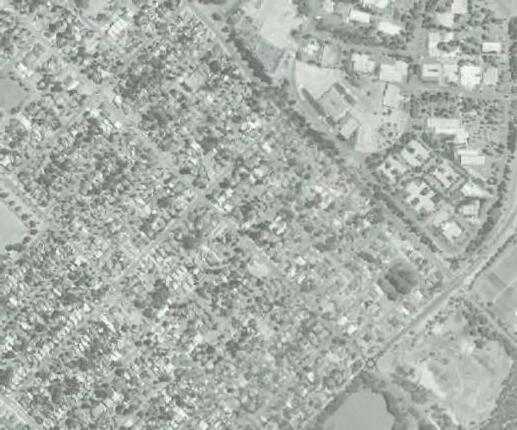




















































































































open spaces and T.of V.P. ecozoning. Propose to leverage off existing T of V.P. $500 garden grant and native plant giveaway programs. LGA demonstration gardens and educational material would further support native bee attracting gardens. Residents and local schools on this beeline route could play sponsorship / custodian role.

2km beeline between Hillview and Goss Ave. remnant bushlands. Utilises verges, street trees, public open space and T.of V.P. ecozoning. Playfield Reserve is a well positioned junction point for Etwell Street and this beeline. This beeline would be more fluid as it is the bee’s navigation choice. Curtin University, South Metropolitan Tafe and Technology Park on this beeline route could play sponsorship custodian role.







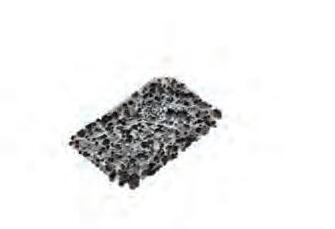



Collier Park Golf Course
(36.4Ha existing Urban Forest between fairways)




Species name Dimensions Flowering habits
Banksia attenuata Candle Banksia 4-8m (H) Yellow candle like flowers (5-26cm long, 3.5-5cm wide), Flowering September to October. Up to 10y before flowering (George, 1987).
Banksia menziesii Firewood Banksia 2-6m (H) Pale pink to deep red with silvery indumentum ovoid-cylindrical flowerhead (4-12cm long, 7-8cm wide). Flowering February to August. Flowers from 6-10y from seed (George 1987).

Brachysome iberidfolia* Swan River Daisy 0.3 - 0.5m (H) 0.2 - 0.3m (W) White, blue, purple, black flowers between spring and summer.













































Calothamnus sanguineus* Silky-leaved Blood Flower 2m Red flowers March to November.
Calytrix angulata* Yellow starflower 1m Star shaped yellow /cream flowers between August and December.
Conostylis candicans Grey cottonhead 0.3-0.8m (H) 0.3-0.8m (W) Campanulate, globular yellow flower on terminal heads winter to summer.
Corymbia calophylla Marri 30-40m (H) Abundant cream white flowers buds and fruits in terminal clusters. Flower January to May. Buds pear shaped on long, slender stalks.
Eucalyptus marginata Jarrah 10-40m (H) Buds cylindrical, caps conical. Umbers 7-17 held on slender peduncles.Creamy white filamentous flowers June to January.
Jacksonia furcellata Grey stinkwood 3m (H) Branchlets crowded, yellow pea flowers August to March.
Jacksonia sericea Waldjumi 0.6m Orange pea flowers December to February.
Jacksonia sternbergiana Green stinkwood 5m Yellow orange pea flowers most of the year.
Gastrolobium capitatum* Bacon and eggs 1m Red and yellow pea flowers June to September.
Gastrolobium nervosum* 0.5m Red and yellow pea flowers July to September.
Hardenbergia comptoniana Native wisteria 0m (climbing) Purple pea flower July to October.
Hemiandra pungens Snake bush 1m Mauve / white flowers January to December.
Hypocalymma robustum* Swan River myrtle 1m Pink wax flowers June to October.
Melaleuca scabra* Rough honey mrytle 0.5 - 1.5m Purple September to December.
Melaleuca seriata* 0.6m Pink filamentous flowers August to December.
Melaleuca thymoides* 0.4 - 2m Yellow / cream flowers September to January.
Melaleuca tricophylla* 0.3-0.8m (H) 0.6-2m (W) Pink, red flowers in spring and summer.
Pultenaea reticulata 2m Yellow / orange pea flower August to December.
Regelia inops* 2.5m (H) 1.5m (W) Purple / pink flower October to January.
Xanthorrhoea preisii Grasstree 4-7m (H) 2-4m (W) Long flowering scape. Inconspicuous white-cream flowers June or August to December every few years. Spike length 1.5-2.5 m.




Fig. 31: Section - “Gateway to the Beelines” at the Kent St. / Hayman Rd. roundabout. Nesting towers also double as wayfinding for the three Beelines (AutoCad, Illustrator, Photoshop).
Fig. 32: Perspective - Drivers fleeting perspective of the roundabout (Photoshop).
Fig. 33: Perspective - Bees perspective of roundabout vegetation. False bee colour view of Hardenbergiacomptoniana (L) and Jacksonia sericea (R). Adapted from Lunau et al, 2021 (Photoshop).



Cavity bees
Fig. 34: Section - Kent St. / Department of Biodiversity Conservation and Attractions (DBCA) (AutoCad, Illustrator, Photoshop).
Perspective - DBCA Living Laboratory to monitor for species density/distribution and nesting intervention effectiveness. Interpretive signage profiles the 50 native bees found in Perth (Photoshop).

Burrowing bees
Fig. 36: Perspective - Public Open Space converted into Bee friendly communal garden (Photoshop).
Cavity bees
Cavity bees

C U L T U R A
R E P O R T W R I T I N G
L A C H 4 4 2 1 [S 2, 2 0 2 3]
UWA Unit Coordinator Rosie Halsmith (with Loren Holmes)
Brief.
Write a report on an appropriate process for the indigenisation of the curriculum. Your report will provide a series of guidelines / recommendations and steps to be taken by the UWA School of Design. These must be developed via specific research on successful examples.
Client.
The UWA School of Design.
Response - Indigenising the Curriculum.
This report provides preliminary principles and recommendations, as well as a proposed process based on analysis of research and case studies. Indigenisation of curriculum should not be a ‘cookie cutter’ of these programs. The School of Design’s program should be situated for the Country that learning and designing is on / about and must be developed respectfully and collaboratively. Students should graduate understanding their role in ‘giving back’ by sensitively applying their Indigenous learning in important reconciliatory and purposeful work.
+ Full unabridged report Indigenising UWA’s School of Design Curriculum
+ Invitation to present at UWA Cultural Awareness Committee Feb. 2024
+ UWA School of Design end of semester exhibition
+ UWA School of Design Summer 2024 exhibition catalogue (1/1 students)
+ UWA School of Design Instagram
1. Report purpose
Indigenisation refers to the “incorporation of Indigenous knowledges, cultures and experiences”¹. This abridged report presents proposed principles, recommendations and a diagrammatic process to indigenise the University of Western Australia (UWA) School of Design curriculum. The original unabridged report, prepared for “LACH4421 Australian Landscapes”, is available here.
2. Justification for indigenisation of curriculum
Indigenisation programs support Indigenous equity, empowerment, self-determination and success as education can be a powerful decolonisation tool² Indigenising curriculum is a core component of University Australia’s “Indigenous Strategy 2022-25”³. Furthermore, indigenising the School of Design’s curricula is an expectation of the peak bodies responsible for accreditation of UWA’s design courses (i.e. AIA, AILA, PIA).
Indigenisation is particularly relevant in design given Indigenous Australians were our first designers. As contemporary designers, graduates who have learnt traditional engagement / practices can support the healing of Country through authentic, respectful engagement and purposeful work. Page and Memmot⁴ describe this as “The New Australian Design”, whereby design of our objects, interiors and places are informed by Indigenous knowledges acquired from thousands of years.
3. UWA current state (summary)
3.1 UWA Strategy
UWA’s Strategy⁵ summarises the strategic direction and priorities of the university up to 2030. The document’s “defining characteristics” and “strategic themes” support broadscale indigenisation of curricula across the university course offerings and culturally competent graduates.
3.2 Reconciliation Action Plan
Reconciliation Action Plans (RAP) assist “businesses to embed the principles and purpose of reconciliation”⁶. Neither the university nor the School of Design had a RAP at the time of compiling the unabridged report.
3.3 Participation
UWA’s Indigenous participation rate is 1.3%⁷, signifying that Indigenous students are still under-represented in higher education given 3.8% of Australians identify as Aboriginal or Torres Strait Islander⁸. UWA has identified strategies for improving participation rates as part of the Indigenous Student Success Program⁹.
3.4 Enrolment status
Enrolment by discipline type and domestic vs international was evaluated. Analysing enrolment metrics can help inform the design of the revised curriculum (e.g. undergraduate programs have higher numbers of domestic students and generally have more free curriculum capacity for indigenous content).
3.5 Design schools
An analysis of four Australian design schools found Architecture typically has less focus on Indigenous knowledges compared to other built environment disciplines, while Landscape Architecture students start with a higher knowledge baseline10. A cursory review of UWA’s current Landscape Architecture indigenisation experience was completed and key observations were collated into a SWOT analysis (also see unabridged report).
4. Case studies (summary)
Two key case studies informed the proposed principles and process presented within this report.
Case study 1 is the UWA Juris Doctor program, which is hosted by the Law school¹. This case study is specific to the Country UWA’s Crawley and Nedland’s campuses are situated upon (i.e. Wadjuk Noongar Boodjar). In addition, both the Law and Design schools work under the same university governance and strategy. This case study could be considered a pilot program for the broader university with many elements such as existing relationships and some of the “Principles of Indigenisation” being potentially transferable. Leveraging off this program may also minimise stakeholder fatigue.
Case study 2 comprises “Indigenous inclusion and Indigenising the University” at the University of Auckland¹¹. This case study was selected because it presents a logical eight-point difference between inclusion and indigenisation, which supports transformation from one to both models.
5. Preliminary principles and recommendations
A review of relevant indigenisation of curriculum literature has also informed the preliminary principles and recommendations presented in Table 1
6. Recommended process
A recommended process is proposed overpage. The co-creation phases of the indigenisation process are expected to be fluid / iterative (figure 1), while pre-work / implementation / monitoring / continuous improvement phases resemble a more conventional project management approach (figure 2). A full explanation of these processes is provided in the unabridged report.
7. Implementation Schedule
Given the iterative nature of co-creating principles and redesigning curricula a detailed schedule is not provided. To do so would be pre-emptive and apply a linear western approach to what should be an Indigenous-led journey (a “wavy line”). That said, the indigenisation of UWA’s Juris Doctor program is a five-year project. Re-accreditation by AIA, AILA and PIA is due in 2027, which could be a tentative target date for launching.
8. Conclusion
This report provides preliminary principles and recommendations, as well as a proposed process based on analysis of research and case studies. Indigenisation of curriculum should not be a “cookie cutter” of these programs. The School of Design’s program should be situated for the Country that learning and designing is on / about and must be developed respectfully and collaboratively. Students should graduate understanding their role in “giving back” by sensitively applying their Indigenous learning in important reconciliatory and purposeful work.
References
1. Kwaymullina, A. 2019. “Teaching for the 21st Century: Indigenising the Law Curriculum at UWA.” Legal Education Review. Vol. 29, no. 1. https://doi.org/10.53300/001c.12080.
2. Pidgeon, M. 2016. “More than a Checklist: Meaningful Indigenous Inclusion in Higher Education. Social Inclusion. Vol. 4(1), 77-91.
3. Universities Australia. 2022. Indigenous Strategy 2022-2025. Indigenous Strategy 2022-25 (universitiesaustralia.edu.au)
4. Page, A. and Memmot, P. 2021. “Design – Building on Country” 1st. ed. Port Melbourne: Thames & Hudson.
5. University of Western Australia, The. n.d.-a. “UWA 2030”. UWA-2030-Full-Report.pdf
6. Reconciliation Australia. n.d.-a. “Reconciliation Action Plan (RAP) Framework”. Reconciliation Australia. Accessed August, 10, and September 28 2023. https://www.reconciliation.org.au/wp-content/uploads/2021/09/RAP-Levels-and-Framework.pdf
7. University of Western Australia, The. 2023. “Annual Report 22” https://www.annualreport.uwa.edu.au/__data/assets/pdf_ file/0005/3690608/180071-UWA-Annual-Report_FINAL_WEB_single-pages.pdf
8. Australian Bureau of Statistics. 2023. “Estimates of Aboriginal and Torres Strait Islander Australians” ABS. https://www.abs.gov.au/ statistics/people/aboriginal-and-torres-strait-islander-peoples/estimates-aboriginal-and-torres-strait-islander-australians/30-june-2021
9. University of Western Australia, The. 2022. “Student Access and Participation Framework 2022–2025.” https://www.governance.uwa. edu.au/__data/assets/pdf_file/0004/3682543/Student-Access-and-Participation-Framework-2022-2025-web.pdf
10. Tucker, R., Loy Chow, D., Heyes, D., Revell, G. and Jones, D. 2018. “Recasting Terra Nullius Blindness: Empowering Indigenous Protocols and Knowledge in Australian University Built Environment Education.” International Journal Technological Design Education, Vol. 28: 303-322. DOI 10.1007/s10798-016-9389-5
11. Hoskins, T.K. and Jones, A. 2022. “Indigenous Inclusion and Indigenising the University” New Zealand Journal of Educational Studies Vol. 57:305–320. https://doi.org/10.1007/s40841-022-00264-1
12. Acton, R., Salter, P., Lenoy, M. and Stevenson, R. 2017. “Conversations on cultural sustainability: stimuli for embedding Indigenous knowledges and ways of being into curriculum”, Higher Education Research & Development, 36:7, 1311-1325, DOI: 10.1080/07294360.2017.1325852
Leonard, B.R. and Ocean R.M. 2016. “Indigenous Struggles Within The Colonial Project: Reclaiming Indigenous Knowledges in the Western Academy.” Knowledge Cultures 4 (3): 99-116.
13. Kennedy, J. Thomas, L., Percy, A., Dean, B., Delahunty, J., Harden-Thew, K. and e Laat, M. 2019. “An Aboriginal way towards curriculum reconciliation”, International Journal for Academic Development, 24:2, 148-162, DOI:10.1080/1360144X.2019.1593172
14. Rigney, L.I. 2011. “Review of Indigenous Higher Education Consultancy: Professor Lester-Irabinna Rigney”, Australian Government, Department of Education. https://www.education.gov.au/access-and-participation/resources/Indigenous-higher-education-reform-andIndigenous-knowledges
15. Demssie, Y.N., Biemans, H.J.A, Wesselink, R. and Mulder, M. 2020. “Combining Indigenous Knowledge and Modern Education to Foster Sustainability Competencies: Towards a Set of Learning Design Principles”, Sustainability Vol.12, no. 17: 6823. https://doi. org/10.3390/su12176823
16. University of Western Australia, The. n.d.-a “Undergraduate Indigenous Knowledge, History and Heritage” Accessed October 3, 2023. https://www.uwa.edu.au/study/Courses/Indigenous-Knowledge-History-and-Heritage
17. University of Western Australia, n.d.-b. “Handbook 2024 Biodiversity on Country [ENVT5310]” Accessed November 20, 2023. https:// handbooks.uwa.edu.au/unitdetails?code=ENVT5310
18. Curtin University. 2023. “CurtinX: Noongar Language and Culture” https://www.edx.org/learn/noongar/curtin-university-noongarlanguage-and-culture
19. University of Western Australia, n.d.-c. “Research Ethics and Compliance”, https://www.research.uwa.edu.au/staff/rebo
20. Australian Institute of Aboriginal and Aboriginal Torres Strait Islander Studies. 2020. AIATSIS Code of Ethics for Aboriginal and Torres Strait Islander Research. AIATSIS. https://aiatsis.gov.au/sites/default/files/2022-02/aiatsis-code-ethics-jan22.pdf
Principles
Guidelines
Belonging in the Western academy UWA must acknowledge and respond accordingly to the premise that Indigenous knowledges are not readily compartmentalised, nor empirical and may not naturally fit into university models.
Respect, recognition and moving together in meaningful ways
An indigenisation program should never misappropriate culture, perpetuate a deficit narrative nor be tokenistic.
Situated for Country The curriculum should be situated for Wadjuk Noongar Country where UWA resides, as well as those Country(ies) where design occurs.
Indigenous led Indigenisation should be Indigenous led (i.e. ”no conversations about us without us”).
Relationships should endure throughout the delivery / continuous improvement of the program.
Deep listening and reflexive thinking Commitment to the practice of deep listening and reflexive analysis.
Iterative The program development / execution should be developed iteratively.
Culturally competent staff Staff receive comprehensive, ongoing cultural awareness training.
Teaching and Learning strategies Content is embedded and not “bolted on” in authentic, engaging ways.
Recommendations
+ Working / Reference groups to monitor for forcing Indigenous perspectives into western frameworks
+ Proposed Indigenisation processes should not rigidly follow a conventional project management framework
+ Onsite meeting spaces for participating Indigenous people should be welcoming and not confronting
+ Reference group to monitor for misappropriation and misrepresentation
+ Must not breach Indigenous Cultural Intellectual Property (ICIP) rights
+ Working / Reference groups to include Wadjuk Noongar Elder participation
+ A network of Country specific Elders to be identified for non-Wadjuk Country
+ Working / Reference groups to include Wadjuk Noongar Elders and a diverse range of Indigenous perspectives (e.g. varying age, gender, sexuality etc)
+ Studios, lectures and field trips to have participating Elders that can speak for Country
+ Consider an elder-in-residence program
+ Elders / experts should be appropriately compensated for their time and generous sharing of knowledge
Respectful research Associated Indigenous based research must be ethically sound.
Culturally sensitive learning spaces / indigenous architecture
Culturally inclusive spaces should be available.
+ The imminent relocation from Nedland’s campus represents a potential experiential design opportunity for students to be involved in new site design and potential unbuilding of old site Table
+ Unit schedules should have in-built flexibility when working with Elders (i.e. consultation is not linear and may not fit within compressed university timeframes)
+ Staff and students are taught the concept, relevance and practice of deep listening and reflexive thinking
+ Working / Reference groups terms of reference provide for iterative input / response
+ Program design is flexible / dynamic allowing for iterative co-creation
+ Evaluate applicability of Juris Doctor staff cultural training
+ Develop a staff cultural training program that is fit-for-purpose for School of Design staff (including sessional staff). This should be competency-based and valid for defined periods
+ Content is integrated horizontally and vertically. All units contain Indigenous content and knowledge taught later in the degree connects to, and builds upon, foundational learning
+ Indigenisation embedded in a range of teaching mediums such as unit readings, lectures / tutorials (delivered by staff and/or expert guests), field trips and studios
+ First-hand interaction and engagement opportunities (i.e. learning from the source)
+ Appropriate capacity available to do the topic justice
+ Leverage off existing Indigenous based units offered in other UWA schools¹⁷ ¹⁸
+ Foundation learning could include learning language ¹⁹
+ International Indigenous knowledges could be considered for world-view perspectives
+ Indigenous-based research principles to align with existing UWA20 and AIATSIS21 ethics requirements
+ Greater Indigenous presence on Nedland’s campus (e.g. people, flags, language, art etc)




O T H E R M L A PR O J E C T S
[2 0 2 2 - P R E S E N T]
+ ARLA4506: Research Strategies [S2, 2023 - Available on Request]
+ LACH4423: Urban Ecology [S1, 2023 - Available on Request]
UWA School of Design end of semester exhibition (1/8 students)
UWA School of Design 2023 Winter brochure (1/1 students)
UWA School of Design Instagram
+ LACH2050: Plants and Landscape Systems [S2, 2022 - Conversion]
UWA School of Design end of semester exhibition (1/4 students)
WA School of Design 2022 Summer brochure (1/1 students)
WA School of Design Instagram
+ ARLA1040: Techniques of Visualisation [S1, 2022 - Conversion]
UWA School of Design end of semester exhibition (~1/8 students)
Research enquiry:
Are urban forest stakeholders more receptive to improved resilience strategies (such as less uniform streetscapes, pre-emptive host species removal and more diverse privately owned tress) as a result of Polyphagus Shothole Borer in Perth?
Research proposal abstract:
Australia’s strict biosecurity regime provides the first line of defence in preventing the entry of pests and diseases. Increased global trade has resulted in invasive species periodically breaching our borders, as evidenced by Polyphagus Shot-hole Borer (PSHB) and Mrytle Rust reaching Western Australia. Both species threaten urban forests (UF).
An analysis of peer-reviewed literature identified most UF research still focuses on ecosystem services. Invasive species specific UF research generally only occurs where infestations are (i.e. international). There is a lag in delivering “research-practice-policy”, so Perth based research may be underway but not yet published. Direct experience with invasive species influences stakeholder support / buy-in, which is generally low otherwise. Knowledge awareness is therefore important as it supports eradication programmes. Despite 85% of UF occurring on private property and the remaining 15% being on public land, most research focuses on the more accessible public data sets. In addition, UF is mostly managed at the municipal level (i.e. LGAs in Australian context) and is not centrally coordinated nor managed consistently. Many studies utilise a socioecological approach to organise systems and evaluate change drivers such as invasive species impacts. Finally, tree diversity such as differing age, species and genetic composition is important in increasing UF resilience to pests and diseases.
This proposal hypothesises that attitudes to UF composition and threats posed by invasive species can be influenced through experience and education and the presence of PSHB in Perth may make decision makers / stakeholders more receptive to supporting eradication programmes and increasing UF diversity. An in-person public perception survey is proposed to evaluate both residents and other relevant stakeholders understanding of invasive species impacts given PSHB’s real-time presence in Perth and ascertain current attitudes to UF diversity - specifically if there is an increased willingness to modify privately owned gardens and public streetscapes to build resilience. The study intends to use photo-realistic renders depicting healthy and diseased tree species, as well as monoculture vs diverse streetscapes to determine perceptions and attitudes. The study will be performed in both inner and outer metropolitan LGAs.
The Western Australian government is mid-way through a three-year eradication strategy for PSHB. There is a real risk the pest will not be contained. As such Perth will require a “Plan B” comprising mitigative strategies such as diversification. The research proposed will contribute knowledge regarding willingness for change beyond UF practitioners, thereby helping to inform urban forest policy and operational management plans.
Urban Forest monoculture streetscape example


The Town of Cambridge recommends E. indica on Joseph Street to “create a magnificent avenue theme that will add character and colour to your street” (Town of Cambridge, n.d.). This suggests prioritising beautification over ecosystem services or ecological integrity. The streets of the Town of Cambridge are still lined mostly with monoculture / homogenised plantings of similar age. Steenberg et al (2017, 123) indicates neighbourhoods with older houses / higher affluence (i.e. West Leederville) are frequently characterised by large, mature trees that provide high levels of ecosystem services.
The Victorian Government (Hortflora n.d.) indicates E. indica is an incorrect naming and should be Erythrinax sykesii, a sterile hybrid clone that is propagated from cuttings (i.e. it has low genetic diversity).
DPIRD (2023-b) has identified Erythrinaxsykesii and Erythrinacaffra as reproductive host trees of PSHB and Erythrinacrista-galli as a non-reproductive host. The genus is an emerging weed in parts of coastal NSW and SE Queensland as it naturalises coastal areas from its clippings.
Urban Forest diverse streetscape example

Both species have similar height and red flowers, which keeps with the “avenue / gardenesque” theme of the suburb. These two trees belong to different families (Fabeaceae and Myrtaceae) and one is exotic, while the other is native.
Planting strategies such as this may help to act as a “circuit breaker” minimising the risk of pest and diseases being spread. Furthermore, if one species is affected by an invasive species and results in tree mortality or tree removal the other species remains and continue to provide UF ecosystem services and ecological integrity.
Fig. 42: Urban Forest monoculture vs diverse streetscapes (InDesign).
Monoculture planting of “Erythrinaindica” (Coral tree) providing shade and amenity (ecosystem services) and associated leaf litter on footpath (disservices). Joseph Street, West Leederville, Town of Cambridge.
Subtle diversification of “Erythrinaindica” (Coral tree) and Callistemon sp. (Bottlebrush). Kimberley Street, West Leederville, Town of Cambridge.
Open woodland - Remnant Banksia woodlands
Location Etwell Street, Kensington. Part of Jirdarup Bushland Precinct. -31° 59’ 17”, 115° 53’ 12”
Total area 10.87 ha (including the 9.1 ha Bush Forever Site no. 048)
Ownership / responsibility Town of Victoria Park
Quadrat size 20 x 20m (approx.)
Origin Natural, pre-colonial.
Conservation Status Designated Threatened Ecological Community (EPBC) “Banksia Woodland of the Swan Coastal Plain” in 2016. Endangered under EPBC Act.
Soil type Quartz based Bassendean sands.
Plant species Open woodland / Kwongan. Dominant species in quadrat are E.todtiana, B. attenuata and B. ilicifolia trees. Understory comprises mid-size shrubs such as A. humilis, A. cygnoram, Jacksonia sp. and dryland sedges and grasses. 208 plant species in whole reserve. Refer images of key species observed. Note: unlikely all species in the quadrat recorded.
Overall % tree canopy cover ~10%
Overall % ground cover ~80%
Species richness 20 (at least)
Vegetation Condition Scale (Keighery scale)
Disturbance
Very good
Fencing minimises risk of trampling, weed and dieback introduction. Bushfire occurred in February 2016, evidence of some trunk blackening on Eucalyptus species. Animal burrowing and consumption of plant matter. Soil and dead plant matter tested negative for dieback in 2017.
Fauna Evidence of Oryctolagus cuniculus (rabbit) via scats, burrows and Pindone® treated carrots present in quadrat. Birds such as Gymnorhina tibicen (magpie) observed. Site visited outside of diurnal cockatoo roosting / foraging times. Insects such as ants observed.
Evidence of management
Revegetation on fence fringe and weeding efforts by Town of Victoria Park and Friends of Jirdarup Bushland. Other management strategies outside of quadrat comprise fencing, limestone paths, seating, interpretive signage, Phytopthora cinnamomi shoe cleaning stations and bird water stations.
Design features Due to this biotope’s endangered status, there is a light touch to the landscape design. The design intent is not to alter the landscape but to protect and restore the vegetation community. A controlled path network and nearby sit spots allow human users to passively enjoy the space.



assessment of Jirdarup (remnant) Bushland (InDesign).
4

Fig.
4: Plant Visual Diary -Banksiagrandis,Platanusxacerifolia,Lepidospermagaldiatum,Brachychitonacerifolius,Stenotaphrumsecundatum,Corymbiacalophylla, Eucalyptusmarginata,Jacarandamimosifolia,Anigozanthosmanglesiiand Liquidambarstyraciflua(left to right) (sepia ink hand drawings).





Priscilla Hubbard
